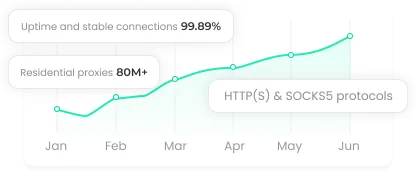Mastering Data Discovery for Smarter Business Decisions
Every day, businesses generate 2.5 quintillion bytes of data. But most of it sits idle, untapped, waiting for someone to make sense of it. That’s where data discovery comes in. It’s not just about collecting data—it’s about finding the right data, understanding it, and turning it into actionable intelligence faster than your competitors. Whether you’re tracking market trends, building analytics pipelines, or enriching business intelligence, data discovery sets the stage for smarter, faster decisions. Let’s break down how to master it—and how tools like web scraping and curated datasets can turbocharge your workflow.

Understanding Data Discovery
Data discovery is the art and science of finding, collecting, and understanding data from diverse sources to reveal patterns, trends, and insights. Think of it as the first step in any data-driven workflow: if you can't find the data, you can't analyze it, predict trends, or make informed decisions.
Unlike traditional data management, which relies on predefined schemas and static databases, data discovery is exploratory and flexible. It taps into structured data—like transaction logs or CRM entries—and unstructured data—from APIs, websites, or third-party datasets.
Manual methods—spreadsheets, keyword searches, queries—work at small scale. But at enterprise scale? They break. Automated discovery tools scan massive datasets, detect relationships, and surface the most relevant information faster and more accurately.
At its core, data discovery is about understanding what data exists, where it comes from, and how it can solve real business problems. As businesses increasingly rely on external sources to complement internal analytics, discovery is no longer optional—it's critical.
The Process of Data Discovery
Data discovery isn't just about finding data; it's about finding the right data, fast. Here's a structured workflow to make it actionable:
Identify Potential Data Sources
Start by mapping where valuable data might exist. Internal systems like CRMs, transaction logs, and customer feedback are obvious. But external sources—websites, public databases, APIs, partner platforms—are increasingly critical. The better your initial mapping, the more efficient your discovery process will be.
Collect and Extract Data
Next, pull that data into a central location. Automated methods—web scraping, APIs, or data feeds—make this scalable. Accuracy, freshness, and completeness are key. Outdated or incomplete data is worse than no data at all.
Organize and Tag
Raw data is messy. Metadata tagging—source, timestamp, type—turns chaos into structure. It ensures your data can be filtered, compared, and interpreted consistently.
Validate and Enrich
Collected data must be trustworthy. Validate accuracy, confirm reliability, and enrich with internal or third-party datasets. This step turns raw numbers into meaningful intelligence.
Visualize and Analyze
Finally, surface insights. Dashboards, exploratory analysis, and visualization tools make patterns visible. From there, you can feed into predictive models, market intelligence reports, or strategic plans.
Common Obstacles in Data Discovery
Even with a solid process, discovery is rarely smooth. Awareness of these challenges allows you to design smarter solutions:
Data Overload: The sheer volume of available data can paralyze teams. Automated tools help, but only when tuned to focus on relevant signals.
Fragmented Sources: Data lives everywhere: websites, cloud storage, spreadsheets, APIs. Integration is complex.
Data Quality: Inconsistent formats, missing fields, outdated info, even deliberate misinformation—these all reduce confidence in insights.
Technical Hurdles: Geo-restrictions, CAPTCHAs, complex front-end frameworks. If your tools can't handle them, you miss valuable data.
Compliance and Ethics: GDPR, CCPA, and privacy regulations make responsible collection non-negotiable.
How Web Scraping and Curated Datasets Accelerate Discovery
Web scraping automates discovery. It extracts structured data from websites at scale, turning hours of manual work into minutes. Modern tools can:
Navigate JavaScript-heavy pages
Bypass geo-restrictions with proxies
Keep data fresh with scheduled scraping
Deliver structured outputs ready for analysis
Scraping becomes a continuous pipeline, feeding dashboards, models, and reports with minimal human intervention.
Curated datasets provide a shortcut. Pre-cleaned, structured, and often industry-specific, these datasets let teams plug in without building pipelines from scratch. For example, analyzing hotel pricing trends across regions is faster when starting with a geolocated, historical dataset rather than collecting manually.
Best Practices for Data Discovery
To maximize impact:
Blend Internal and External Sources: Internal data tells part of the story. External signals fill the gaps.
Define Objectives Clearly: Know what you want to achieve. Market insights? Customer pain points? Competitor tracking? Clear goals improve efficiency and relevance.
Automate Intelligently: Scale your efforts with scraping tools and dataset subscriptions. Focus human effort on interpretation, not collection.
Validate and Refresh: Old or incomplete data kills decision-making. Cross-reference, schedule updates, and work with trusted providers.
Stay Compliant and Transparent: Respect privacy and data ownership. Choose partners who document compliance.
Partner with Experts: Experienced providers offer flexible access, responsive support, and solutions tailored to your industry.
The Bottom Line
Data discovery is the starting point for smarter decisions. When executed effectively, it transforms raw data into a strategic advantage, but when done poorly, it wastes time, effort, and introduces risk. As tools continue to evolve, your approach must evolve as well. By combining structured processes, automation, and high-quality data sources, you can elevate your business insights to new heights.


















































